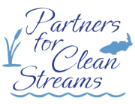 Partners for Clean Streams was founded in 2007. But last year was the 25th anniversary of Clean Your Streams Day. How does that math work out? The answer lies in the origin story for PCS, with the group now called the Maumee Area of Concern Advisory Committee (MAAC). Now’s your chance to go behind-the-scenes and learn how this group launched PCS and where we’ve grown from there to today.
Partners for Clean Streams was founded in 2007. But last year was the 25th anniversary of Clean Your Streams Day. How does that math work out? The answer lies in the origin story for PCS, with the group now called the Maumee Area of Concern Advisory Committee (MAAC). Now’s your chance to go behind-the-scenes and learn how this group launched PCS and where we’ve grown from there to today.
Gather around for a short history lesson, with lots of acronyms but also a deep water partnership story.
In the 1970s, the United States and Canada were growing concerned with protecting the Great Lakes. These critical waterways provide drinking water for millions of people, avenues for billions of dollars of trade, plus countless opportunities for recreation. In 1972, the U.S. and Canada made their commitment official to restore and protect the Great Lakes, by jointly signing the Great Lakes Water Quality Agreement. This Agreement was far-sighted. It focused not just on the lakes themselves, but on rivers and other tributaries that made up Great Lakes watersheds.
Over the years, the Agreement was amended but with the same intentions. In 1987, an amendment established the Maumee Area of Concern (AOC), designating a portion of the lower Maumee River and nearby Lake Erie tributaries as a region that needed special attention. The Maumee AOC was given a report card of beneficial use impairments (BUIs): ways of measuring environmental damage and our grades weren’t so great. Some example BUIs include “Restrictions on Fish and Wildlife Consumption,” “Beach Closings” or “Degradation of Aesthetics.”
In order to address and remove these BUIs, the Toledo Metropolitan Area Council of Governments (TMACOG) set up a Maumee Remedial Action (RAP) Committee. This Committee was made up of government officials, businesses, industries, universities, and other interested individuals with a passion for fishable, swimmable, and drinkable water. The first Clean Your Streams Day was held in 1997, organized by RAP Committee members to work on BUI 11: “Degradation of Aesthetics!”
From 2003 – 2006, the RAP Committee undertook an ambitious effort to create the regional Watershed Restoration Plan, combining requirements from international, federal, and state watershed guidelines. To provide a dynamic, readily accessible, and current plan, partners on the RAP Committee later developed an online Data Management and Delisting System (DMDS), which is still used and updated today. The DMDS provides relevant data specific to the BUIs, the status of the BUIs throughout the AOC, updates to projects in the AOC, and other resources.
But still – where does PCS come in? After much discussion, the Maumee RAP Committee determined in early 2007 that their best path forward for efficiency, effectiveness, and sustainability would be to form a new non-profit 501(c)3 organization and to leave the umbrella of TMACOG. In March 2007, Partners for Clean Streams was officially created.
The Maumee RAP Committee is now a stand-alone committee, reformed and renamed the Maumee AOC Advisory Committee (MAAC). PCS helps facilitate meetings and encourage a pipeline of targeted projects. There are still many different partners participating. Despite all the name changes, the RAP and MAAC have continued to work with the community to support funding and needs for major investigations and prioritize habitat restoration work to help make progress on improving the habitat and nearby waters in the AOC. Meanwhile, PCS continues to engage the community on education, engaging with new partners, leading restoration projects, and of course, stream cleanups. We’ve continued to grow and expand Clean Your Streams Day, even though its older than we are!
History lesson over! Don’t worry, there won’t be a pop quiz.
